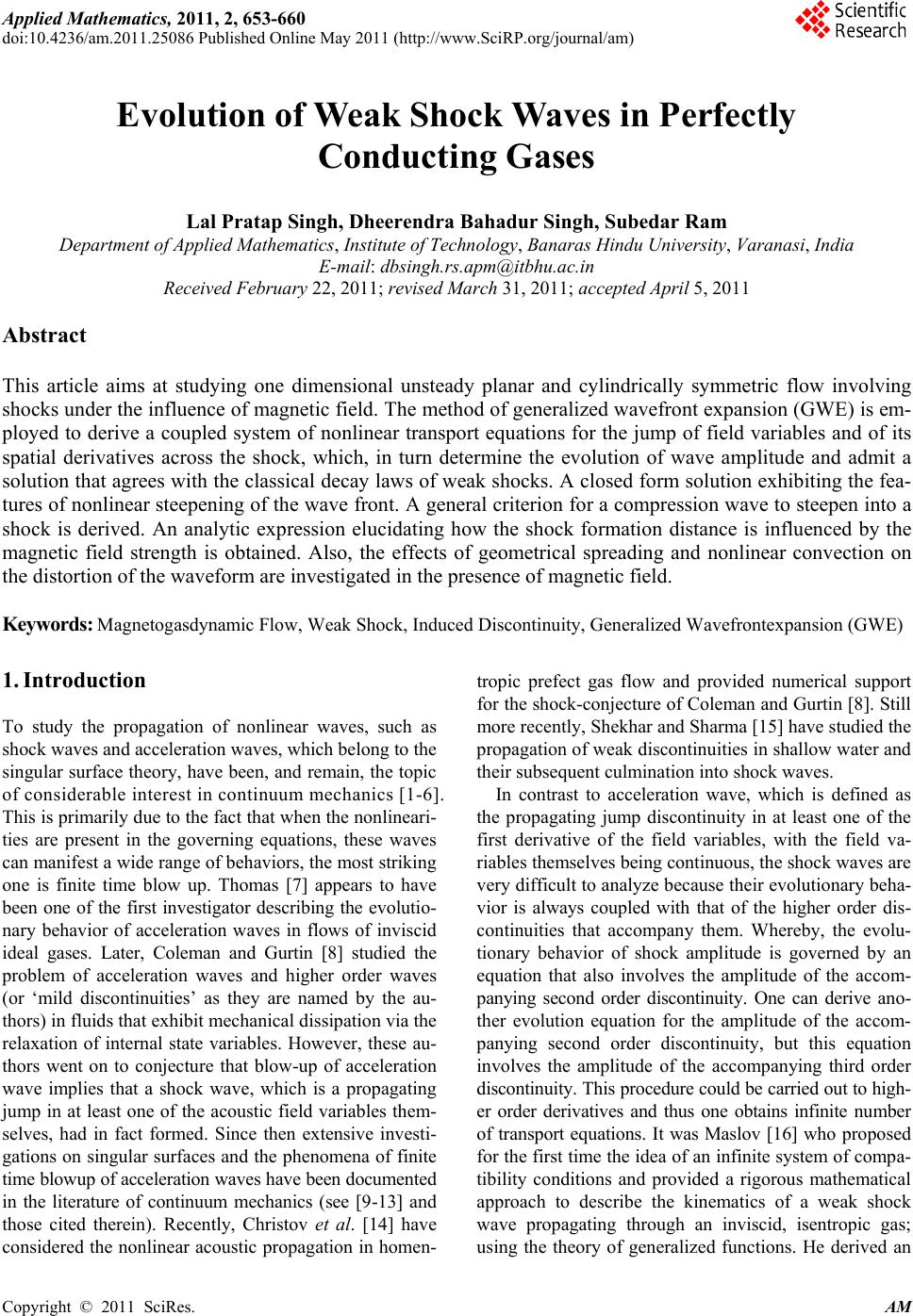 Applied Mathematics, 2011, 2, 653-660 doi:10.4236/am.2011.25086 Published Online May 2011 (http :/ /www.SciRP.org/journal/am) Copyright © 2011 SciRes. AM Evolution of Weak Shock Waves in Perf ectly Conducting Gases Lal Pratap Singh, Dheerendra Ba hadur Singh, Subedar Ram Department of Applied Mathematics, Institute of Technology, Ban aras Hindu Universit y, Varanasi, India E-mail: dbsingh.rs.apm@itbhu.ac.in Received February 22, 2011; revised March 31, 2011; accepted April 5, 2011 Abstract This article aims at studying one dimensional unsteady planar and cylindrically symmetric flow involving shocks under the influence of magnetic field. The method of generalized wavefront expansion (GWE) is em- ployed to derive a coupled system of nonlinear transport equations for the jump of field variables and of its spatial derivatives across the shock, which, in turn determine the evolution of wave amplitude and admit a solution th at agrees with the classical decay laws of weak shocks. A clo sed form solution exhibiting the fea- tures of non linear steepening of the wave front. A general criterion for a compression wave to steepen i nto a shock is derived. An analytic expression elucidating how the shock formation distance is influenced by the magnetic field strength is obtained. Also, the effects of geometrical spreading and nonlinear convection on the distorti on of the waveform are investigated in the presence of magnetic field. Keywords: Magnetogasdynamic Flow, Weak Shock, Induced Discontinuity, Generalized Wavefrontexpansion (GWE) 1. Introducti o n To study the propagation of nonlinear waves, such as shock waves and acceleration waves, which belong to the singular surface theory, have been, and remain, the topic of considerable interest in continuum mechanics [1-6]. This is primarily due to the fact that when the nonlineari- ties are present in the governing equations, these waves can manifest a wide range of behaviors, the most striking one is finite time blow up. Thomas [7] appears to have been one of the first investigator describing the evolutio- nary behavior of acceleration waves in flows of inviscid ideal gases. Later, Coleman and Gurtin [8] studied the problem of acceleration waves and higher order waves (or ‘mild discontinuities’ as they are named by the au- thors) in fluids that exhibit mechanical d issipation v ia the relaxation of internal state variables. However, these au- thors went on to conjecture that blow-up of acceleration wave implies that a shock wave, which is a propagating jump in at least one of the acoustic field variables the m- selves, had in fact formed. Since then extensive investi- gations on singular surfaces and the phenomena of finite time blowup o f acceleration wav es have been d ocumented in the literature of continuum mechanics (see [9-13] and those cited therein). Recently, Christov et al. [14] have considered the nonlinear acoustic propagation in homen- tropic prefect gas flow and provided numerical support for the shock-conjecture of Coleman and Gurtin [8]. Still more recently, Shekhar and Sharma [15] have studied the propagation of weak discontinuities in shallow water and their subsequent culmination into shock waves. In contrast to acceleration wave, which is defined as the propagating jump discontinuity in at least one of the first derivative of the field variables, with the field va- riables themselves being continuous, the shock waves are very difficult to analyze because their evolutionary beha- vior is always coupled with that of the higher order dis- continuities that accompany them. Whereby, the evolu- tionary behavior of shock amplitude is governed by an equation that also involves the amplitude of the accom- panying second order discontinuity. One can derive ano- ther evolution equation for the amplitude of the accom- panying second order discontinuity, but this equation involves the amplitude of the accompanying third order discontinuity. This procedure could be carried out to high- er order derivatives and thus one obtains infinite number of transport equations. It was Maslov [16] who proposed for the first time the idea of an inf inite system of compa- tibility conditions and provided a rigorous mathematical approach to describe the kinematics of a weak shock wave propagating through an inviscid, isentropic gas; using the theory of generalized functions. He derived an 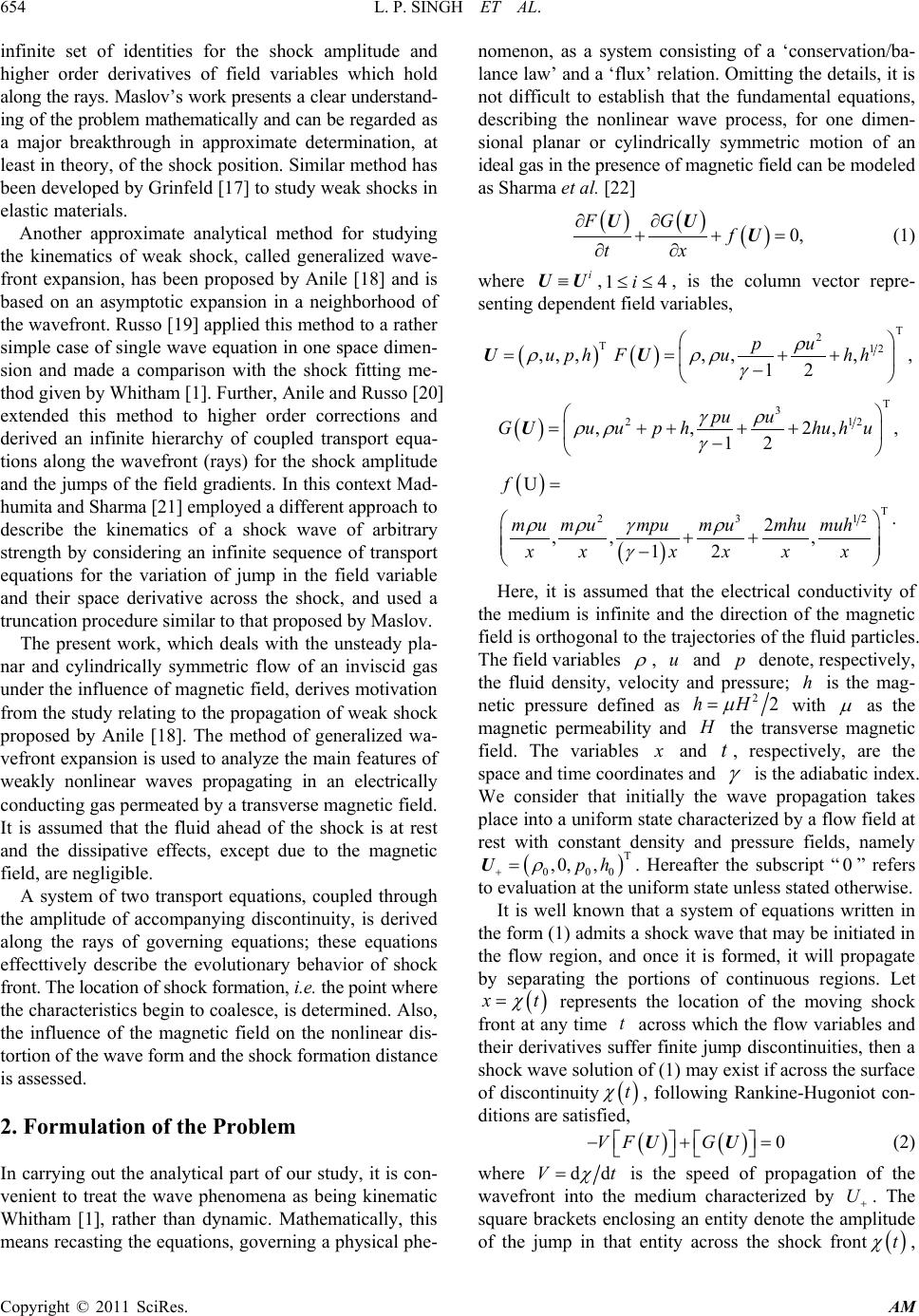 L. P. SINGH ET AL. Copyright © 2011 SciRes. AM infinite set of identities for the shock amplitude and higher order derivatives of field variables which hold along the rays. Maslov’s work presents a clear under stand- ing of the problem mathematically and can be regarded as a major breakthrough in approximate determination, at least in theory, of the shock position. Similar method has been developed by Grinfeld [17] to study weak shocks in elastic materials. Another approximate analytical method for studying the kinematics of weak shock, called generalized wave- front expansion, has been proposed by Anile [18] and is based on an asymptotic expansion in a neighborhood of the wavefront. Russo [19] applied this method to a rather simple case of single wave equation in one space dimen- sion and made a comparison with the shock fitting me- thod given by Whitham [1]. Furthe r, Anile and Russo [20] extended this method to higher order corrections and derived an infinite hierarchy of coupled transport equa- tions along the wavefront (rays) for the shock amplitude and the jumps of the field gradients. In this context Mad- humita and Sharma [21] employed a different approach to describe the kinematics of a shock wave of arbitrary strength by considering an infinite sequence of transport equations for the variation of jump in the field variable and their space derivative across the shock, and used a truncation pro cedure similar to that proposed by Maslov. The present work, which deals with the unsteady pla- nar and cylindrically symmetric flow of an inviscid gas under the influence of magn etic field, derives motivation from the study relating to the propagation of weak shock proposed by Anile [18]. The method of generalized wa- vefront expansion is used to analyze the main features of weakly nonlinear waves propagating in an electrically conducting gas permeated by a transverse magnetic field. It is assumed that the fluid ahead of the shock is at rest and the dissipative effects, except due to the magnetic field, are negligible. A system of two transport equations, coupled through the amplitude of accompanying discontinuity, is derived along the rays of governing equations; these equations effecttively describe the evolutionary behavior of shock front. The loc ati on of s hoc k formation, i.e. the point where the characteristics begin to coalesce, is determined. Also, the influence of the magnetic field on the nonlinear dis- tortion of the wave form and the shock formation distance is assessed. 2. Formulation of the Problem In carrying out the analytical part of our study, it is con- venient to treat the wave phenomena as being kinematic Whitham [1], rather than dynamic. Mathematically, this means recasting the equations, governing a physical phe- nomenon, as a system consisting of a ‘conservation/ba- lance law’ and a ‘flux’ relation. Omitting the details, it is not difficult to establish that the fundamental equations, describing the nonlinear wave process, for one dimen- sional planar or cylindrically symmetric motion of an ideal gas in the pres ence o f magnetic field can be modeled as Sharma et al. [22] ( )( )( ) 0, FG f tx ∂∂ + += ∂∂ UU U (1) where , , is the column vector repre- senting dependent field variables, ( ) T 212 ,, , 12 pu F uhh ρ ρρ γ = ++ − U , ( ) T 3 2 12 , ,2, 12 pu u Guuphhu hu γρ ρρ γ =+++ + − U, ( ) ( ) T 23 12 U 2 ,, , 12 f m um umpum umhumuh xxxxx x ρργρ γ = ++ − . Here, it is assumed that the electrical conductivity of the medium is infinite and the direction of the magnetic field is orthogonal to the trajectories of the fluid par ticles. The field variables , and denote, respectively, the fluid density, velocity and pressure; is the mag- netic pressure defined as with as the magnetic permeability and the transverse magnetic field. The variables and , respectively, are the space and time coordinates and is the adiabatic index. We consider that initially the wave propagation takes place into a uniform state characterized by a flow field at rest with constant density and pressure fields, namely . Hereafter the subscript “ ” refers to evaluation at the uniform state unless stated otherwise. It is well known that a system of equations written in the form (1) admits a shock wave that may be initiated in the flow region, and once it is formed, it will propagate by separating the portions of continuous regions. Let represents the location of the moving shock front at any time across which the flow variables and their derivatives suffer finite jump discontinuities, th en a shock wave solution of (1) may exist if across the surface of discontinuity , following Rankine-Hugoniot con- ditions are satisfied, ( )( ) 0VF G − += UU (2) where is the speed of propagation of the wavefront into the medium characterized by U+. The square brackets enclosing an entity denote the amplitude of the jump in that entity across the shock front , 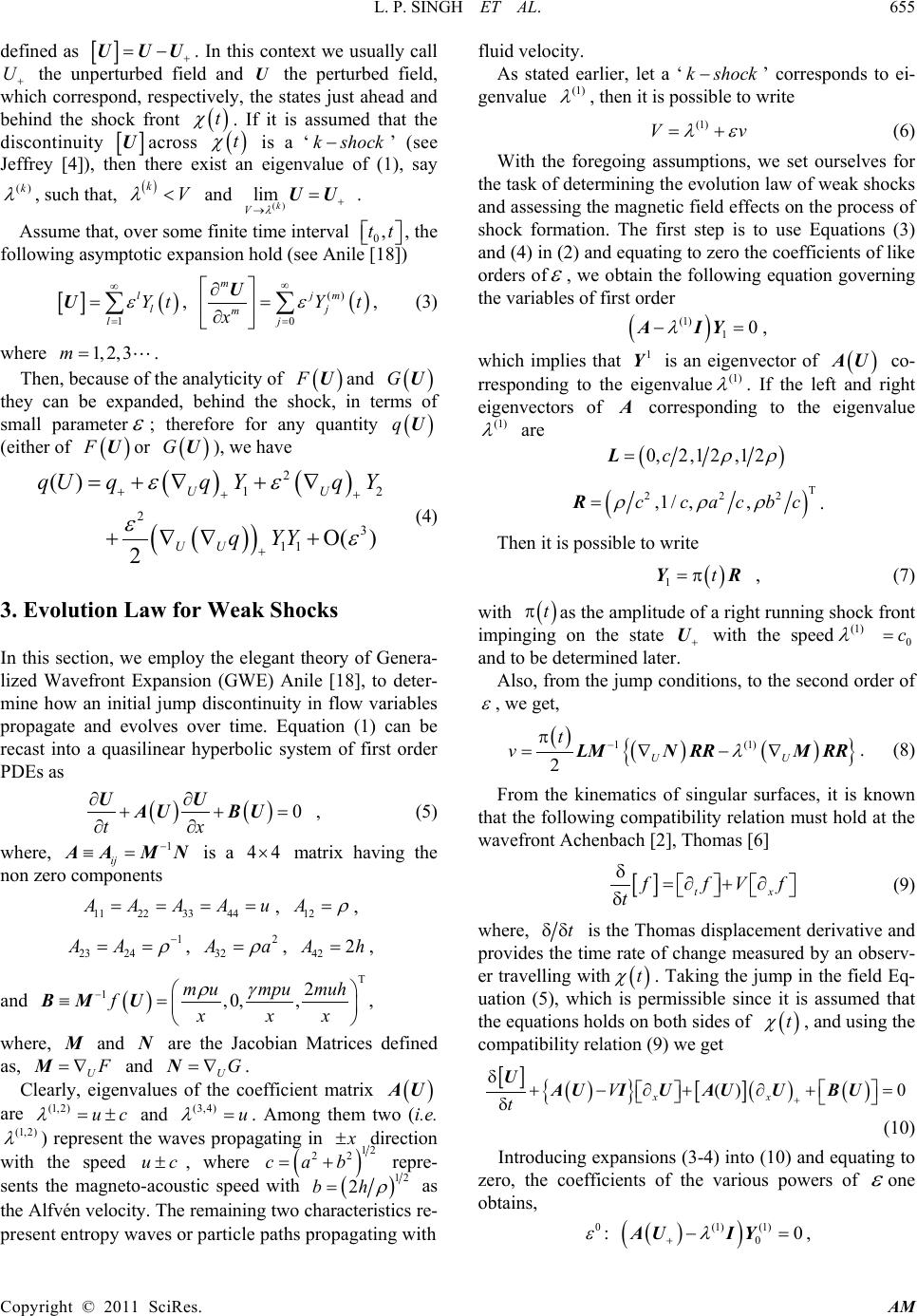 L. P. SINGH ET AL. Copyright © 2011 SciRes. AM defined as . In this context we usually call + the unperturbed field and the perturbed field, which correspond, respectively, the states just ahead and behind the shock front . If it is assumed that the discontinuity across is a ‘ ’ (see Jeffrey [4]), then there exist an eigenvalue of (1), say , such that, and . Assume that, over some finite time interval , the following asymptotic expansion hol d (s e e Anile [18]) , ( ) () 0 mjm j mj Yt x ε ∞ = ∂= ∂ ∑ U , (3) where . Then, because of the analyticity of and they can be expanded, behind the shock, in terms of small parameter ; therefore for any quantity (either of or ), we have ( )( ) ( ) ( ) 2 12 23 11 () () 2 UU UU qU qqYqY q YY εε εε +++ + = +∇+∇ +∇∇+Ο (4) 3. Evolution Law for Weak Sh o cks In this section, we employ the elegant theory of Genera- lized Wavefront Expansion (GWE) Anile [18], to deter- mine how an initial jump discontinuity in flow variables propagate and evolves over time. Equation (1) can be recast into a quasilinear hyperbolic system of first order PDEs a s , (5) where, is a matrix having the non zero components , , , , , and ( ) T 1 2 ,0, , m umpumuh fx xx ργ − ≡= BM U , where, and are the Jacobian Matrices defined as, and . Clearly, eigenvalues of the coefficient matrix are and . Among them two (i.e. ) represent the waves propagating in direction with the speed , where repre- sents the magneto-acoustic speed with as the Alfvén velocity. The re maining two character istics re- present entropy waves or particle paths propag a ting with fluid velocity. As stated earlier, let a ‘ ’ corresponds to ei- genvalue , then it is possible to write (6) With the foregoing assumptions, we set ourselves for the task of determining the evolution law of weak shocks and assessing the magnetic field effects on the process of shock formation. The first step is to use Equations (3) and (4) in (2) and equating to zero the coefficients of like orders of , we obtain the following equation governing the variables of first order , which implies that is an eigenvector of co- rresponding to the eigenvalue . If the left and right eigenvectors of corresponding to the eigenvalue are ( ) T 2 22 ,1/,,ccac bc ρ ρρ =R . Then it is possible to write , (7) with as the amplitude of a right running shock front impinging on the state + U with the speed and to be determined later. Also, from the jump conditions, to the second order of , we get, ( ) ( )() { } 1 (1) 2 UU t v λ − π =∇ −∇LMN RRM RR . (8) From the kinematics of singular surfaces, it is known that the following compatibility relation must hold at the wavefront Achenbach [2], Thomas [6] [ ] tx ffV f t δ=∂ +∂ δ (9) where, is the Thomas displacement derivative and provides the time rate of change measured by an observ- er travelling with . Taking the jump in the field Eq- uation (5), which is permissible since it is assumed that the equations holds on both sides of , and using the compatibility relation (9) we get ( ) { } [ ] ( ) ( ) () 0 xx V t + δ +− ∂+∂+= δ UAUIUAUUB U (10) Introducing expansions (3-4) into (10) and equating to zero, the coefficients of the various powers of one obtains, : ,  L. P. SINGH ET AL. Copyright © 2011 SciRes. AM which implies, (11) : ( ) ( ) ( ) ( ) ( )()( ) (1) (1)(1) 11 10 11 d d 0 U UxU v t λ ++ ++ + +−+∇ − +∇∂ +∇= YAUIYAYIY AY UBY . Here, is the derivative taken along the rays, which implies that, . The above equation, after lef t multiplication b y and using Equations (7), (8) and (11), yields the following ordinary differential equation (12) where, and , with as the Alfvén number. In deriving Equation (12), we have made use of the re- lation, It evidently follows from Equation (12) that the temporal evolution of shock am- plitude at any time depends not only on the shock strength, its curvature and the dissipation on account of applied magnetic field but also on the function . Since the quantity is still unknown, this equation is, how- ever, unable to give an analytical description of the com- plete evolutionary behavior of the wave front. We, there- fore, need to work out certain aspects in more detail. 4. Evolution of Accompanying Discontinuity In order to proceed further, it is necessary to obtain a transport equation for , which may be think of as the amplitude of jump in the slope of unsteady disturbance at the wave front. To achieve this goal, we proceed as fol- lows: We differentiate Equation (5) with respect to ahead and behind the shock and subtract these equations writ- ten ahead and behind the shock. The resulting equation, after using equations the compatibility relatio n (9) g ives ( ) ( ) ( )( )() () () ( ) ( ) ( )( )() ( ) 2 2 0. xx Ux xU x x Ux xx U xxUx Ux VI t + ++ ++ + δ∂ + −∂ δ +∇∂∂ +∇∂∂ +∇∂∂ +∂ +∇∂∂+∇ ∂ +∇ ∂= UAU U AUUAU U A UUAUU AU UBU BU The above equation after using expansions (3-4) and left multiplying by , while zeroth order terms only are retained, yields the following compatibility equation (13) It follows immediately tha t Equation (13) does not con- tain any unknown term and thus the system of compati- bility equations for weak shocks is closed at the second compatibility equation. Also, it may be noticed that the evolution Equation (16) contains only the zeroth order terms therefore the derivation is valid only if the ampli- tude of accompanyi n g discont i nuities are of . It is interesting to notice that Equatio n (13) is in the form of Bernoulli type equation which governs the evo- lutionary behavior of acceleration waves in nonlinear material media and elsewhere. In (13) the linear term depends upon the unperturbed conditions of the me- dium and it takes into account the gradient in the flow variables as well as the geometry of the problem. The ne- gative value of corresponds for compression waves and positive for expansion waves. The coefficient of non- linear term, , which is positive for most of the fluids, is responsible for the nonlinear steepening of the wave front. However, in past years, fluids with negative non- linearity have been found Murlidharan and Sujith [23]. The present paper deals with positive values of . Thus, the nonlinear term makes a negative value of more negative and a positive value of less positive, that is, the nonlinearity alone causes a compression wave to steepen and an expansion wave to relax. 5. Results and Discussion As Equation (13) is of the form which describes the evo- lutionary behavior of wave amplitude in various gasdy- namic regimes [9-13] and therefore the analysis of this equation concerning the local behavior of wave ampli- tude follows on parallel lines. However, to investigate the magnetic field effects on the process of nonlinear steepening of wave front we rewrite Equations (12) and (13) in non -dimensiona l fo rm as (14) (15) where, , , , and are dimensionless quantities defined as , , and with as the Alfvén number and as the dimensionless measure of the strength of the initial jump discontinuity in the field gradients. Indeed, these two transport equations govern the evolutionary behavior of the shock amplitude as well as the jump in the first order gradient of the field variables. In deriving Equa- tions (14) and (15) we have made use of the characteris- tic relation (16)  L. P. SINGH ET AL. Copyright © 2011 SciRes. AM Performing required integration subject to the initial conditions for and at , say and , the Equations (14) and (15) along with the characteristic relation (16) yield the following so lutions . Plane case : Integrating Equations (14) and (15) subject to the above initial conditions yield , (17) . (18) Cylindrical case : In this case the solution of Equations (14) and (15) takes the following form ( ) { } 1 1/221/2 12 1xx ψα − −− =+ΓΘ− (19) ( ) ( ) {} 1/2 2 1/2 12 1xx α − − π =+ΓΘ− (20) 5.1. Nonlinear Steepening of the Wave Front Since and are positive quantities and is an increasing function of , therefore it follows from (17)-(20) that the behavior of and will depend on sign of and hence that of . It is evident from Equations (17)-(20) that if is positive (i.e. an expan- sion wave front with ), as well as decreas- es as the expansion wav e advan ces in direction. While for negative values of (i.e. a compression wave with ), and increases monotonically and the solu- tion provided by (17)-(20) no longer remains valid and steepens into a shock wave after a finite running length . In fact, the weak shock assumption breaks down be- fore and approach to infinitely large values and existence of the distance may be regarded as an in- dication of this. A simple physical explanation of the ap- pearance of shock wave may be that it is formed owing to the inertial overtaking of flow particles, that is when the first characteristic could intersect the successive one. Thus a shock can form only when initial disturbance is compressive and the corresponding shock formation dis- tance in the above two cases (for ) are given by Plane case: , Cylindrical case: . 5.2. Comparison with Exact Results for Decay of Weak Shocks For large values of the asymptotic behavior of plane and cylindrical shock waves is shown in the flollowing table. From Table 1 it is clear that for plane waves and therefore, width of the plane shock, i.e. Table 1. Decay behavior of weak shock waves and first or- der discont inuities. Shock strength First order discontinuity Shock width varies as Plane case Cylindrical case the distance between shock front and tail of the rarefac- tion wave increases like . Also, for cylindrical waves, and therefore, width of the cylindrical shock waves increase like . These results are in closed agreement with the earlier results obtained by Whitham [1, pp. 312-322], Courant and Frie drichs [24, pp. 164-168] and by Landau [25]. Now our objective is to investigate how the nonlinear steepening or flattening of the wave form is influenced by the presence of magnetic field. For the sake of com- parison, the integral curves for Equations (17)-(20) are sketched in the Figures 1-9. These curves help to illu- strate the effect of magnetic field strength, which enters through an increase in the Alfvén number , and the geometry of the problem on the nonlinear steepening or flattening of the wave. Figures 1-4 illustrate the magnetic field effects on the flattening of expansion waves for both the cases, that is, weak shock ( ) and correspnding accompanying dis- continuity ( ). It is evidently clear from Figures 1 and 2 that a cylindrical wave attenuate faster than a plane wave as one would expect and the attenuation rate is decreased by the dissipative mechanism due to presence of magnetic field strength ( ) as compared to what it would be in non-magnetic case . Also, from Fi- gures 3 and 4 we infer that the amplitude of the first order discontinuity , which accompany the weak shock, decays more rapidly as compared to the shock amplitude itself. As discussed earlier that only compressive waves can evolve into a shock and the corresponding situations are depicted in the Figures 5-8, showing thereby that, for compression waves, an increase in the magnetic field strength delays the onset of shock. Also, it is clear from these figures that amplitude of accompanying disconti- nuity ( ) steepen more rapidly in comparision to the shock amplitude itself. Figure 9 shows the variation of shock formation dis- tance with changes in the value of the initial jump . It may be noticed that an increase in the magnetic field strength enhances the shock formation distance. How- ever, higher values of the initial jump and hence lead to sh ort er shock f ormation di s t a nc e . 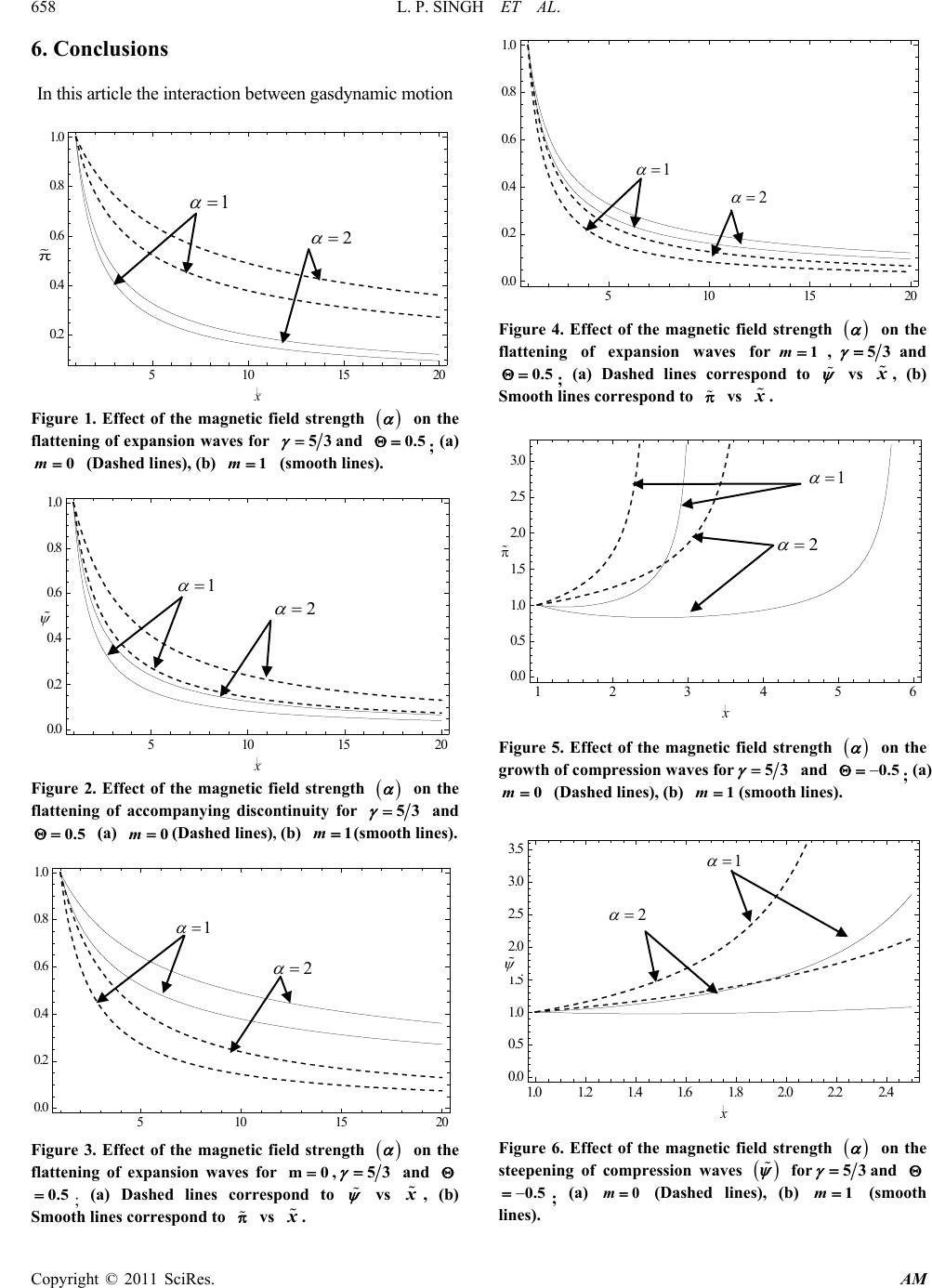 L. P. SINGH ET AL. Copyright © 2011 SciRes. AM 6. Conclusions In thi s a rticl e the i ntera cti on betwee n gas dynam ic m otion Figure 1. Effect of the magnetic field strength on the flattening of expansion waves for and ; (a) (Dashed lines), (b) (smooth lines). Figure 2. Effect of the magnetic field strength on the flattening of accompanying discontinuity for and (a) (Dashed lines), (b) (smooth lines). Figure 3. Effect of the magnetic field strength on the flattening of expansion waves for , and ; (a) Dashed lines correspond to vs , (b) Smooth lines correspond to vs . Figure 4. Effect of the magnetic field strength on the flattening of expansion waves for , and ; (a) Dashed lines correspond to vs , (b) Smooth lines correspond to vs . Figure 5. Effect of the magnetic field strength on the growth of compression waves for and ; (a) (Dashed lines), (b) (smooth lines). Figure 6. Effect of the magnetic field strength on the steepening of compression waves for and ; (a) (Dashed lines), (b) (smooth lines). 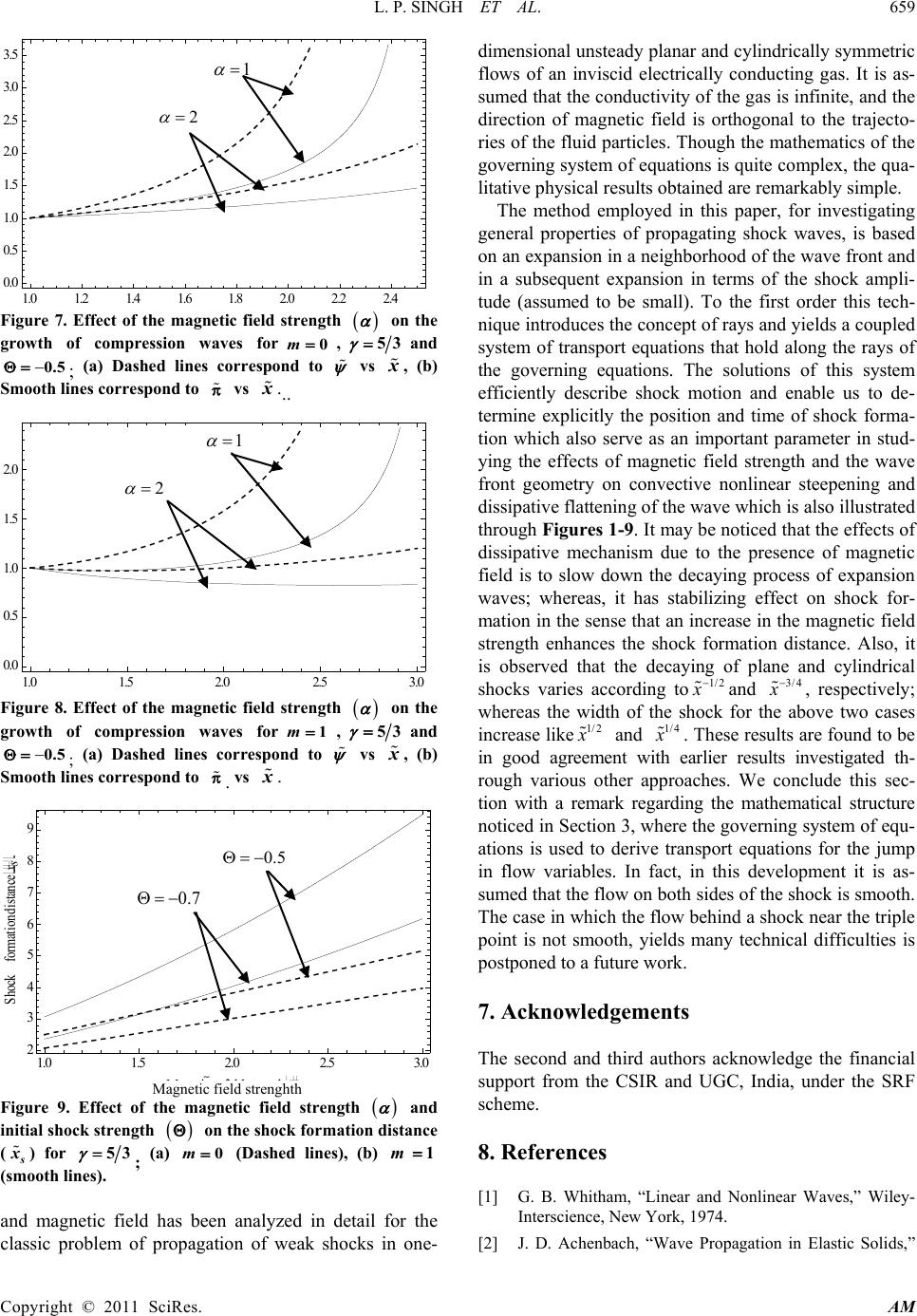 L. P. SINGH ET AL. Copyright © 2011 SciRes. AM Figure 7. Effect of the magnetic field strength on the growth of compression waves for , and ; (a) Dashed lines correspond to vs , (b) Smooth lines correspond to vs ... Figure 8. Effect of the magnetic field strength on the growth of compression waves for , and ; (a) Dashed lines correspond to vs , (b) Smooth lines correspond to . vs . Figure 9. Effect of the magnetic field strength and initial shock strength on the shock formation distance ( ) for ; (a) (Dashed lines), (b) (smooth lines). and magnetic field has been analyzed in detail for the classic problem of propagation of weak shocks in one- dimensional unsteady planar and cylindrically symmetric flows of an inviscid electrically conducting gas. It is as- sumed that the conductivity of the gas is infinite, and the direction of magnetic field is orthogonal to the trajecto- ries of the fluid particles. Though the mathematics of th e governing system of equations is quite complex, the qua- litative physical results obtained are r e markably simple. The method employed in this paper, for investigating general properties of propagating shock waves, is based on an expansion in a neighborhood of the wave front and in a subsequent expansion in terms of the shock ampli- tude (assumed to be small). To the first order this tech- nique introduces the concept of rays and yields a coupled system of transport equations that hold along the rays of the governing equations. The solutions of this system efficiently describe shock motion and enable us to de- termine explicitly the position and time of shock forma- tion which also serve as an important parameter in stud- ying the effects of magnetic field strength and the wave front geometry on convective nonlinear steepening and dissipative flattening of the wave which is also illu strated through Figures 1-9. It may be noticed that the effects of dissipative mechanism due to the presence of magnetic field is to slow down the decaying process of expansion waves; whereas, it has stabilizing effect on shock for- mation in the sense that an increase in the magnetic field strength enhances the shock formation distance. Also, it is observed that the decaying of plane and cylindrical shocks varies according to and , respectively; whereas the width of the shock for the above two cases increase like and . These results are found to be in good agreement with earlier results investigated th- rough various other approaches. We conclude this sec- tion with a remark regarding the mathematical structure noticed in Section 3, where the governing system of equ- ations is used to derive transport equations for the jump in flow variables. In fact, in this development it is as- sumed that the flow on both sides of the shock is smooth. The case in which the flow behind a shock near the triple point is not smooth, yields many technical difficulties is postponed to a future work. 7. Acknowledgements The second and third authors acknowledge the financial support from the CSIR and UGC, India, under the SRF scheme. 8. References [1] G. B. Whitham, “Linear and Nonlinear Waves,” Wiley- Interscience, New York, 1974. [2] J. D. Achenbach, “Wave Propagation in Elastic Solids,” Magnetic fieldstrength Shock formatio ndistance x s Magnetic field strenghth 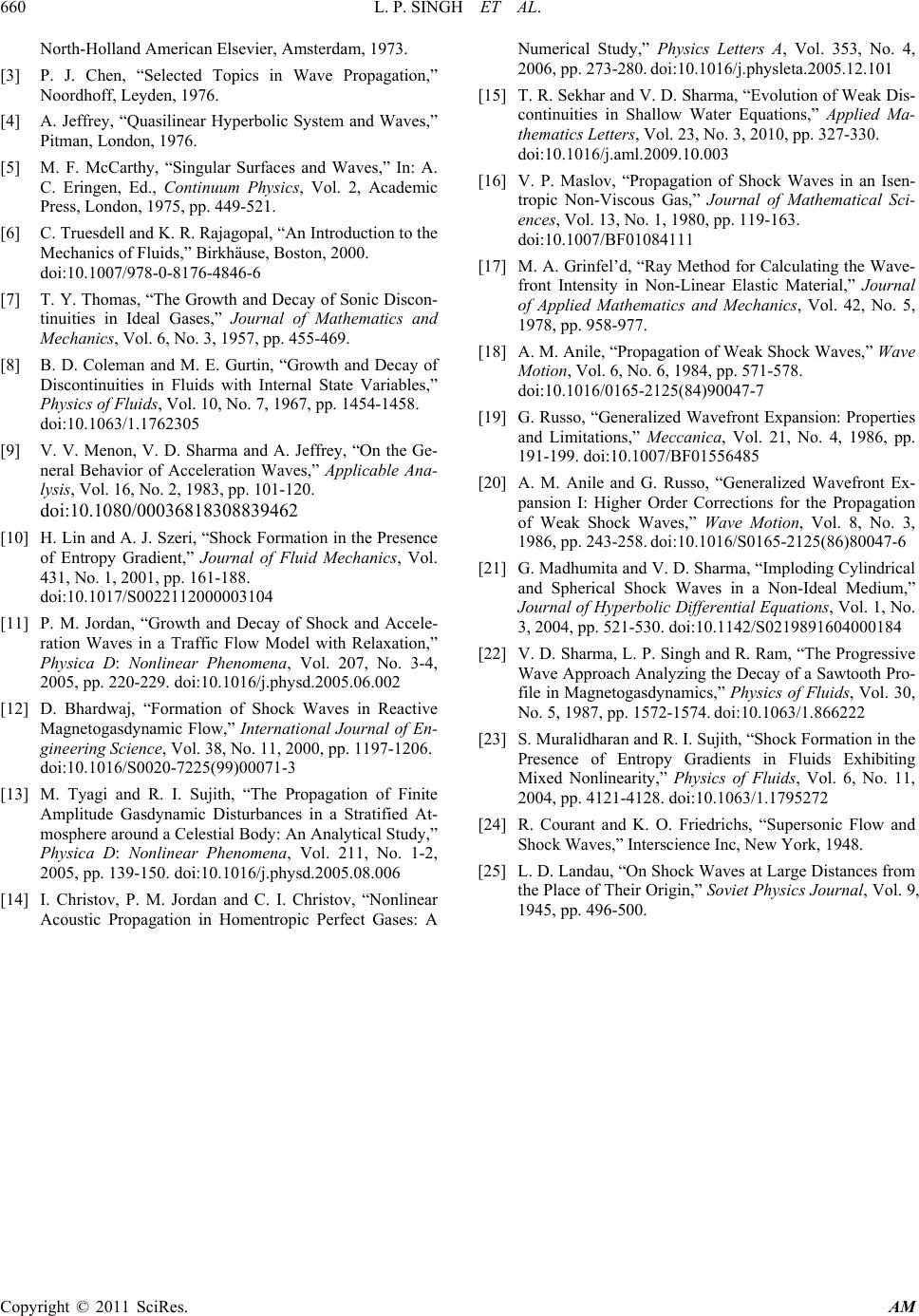 L. P. SINGH ET AL. Copyright © 2011 SciRes. AM North-Holland Am er ican E lsevier, Amsterd am, 1973. [3] P. J. Chen, “Selected Topics in Wave Propagation,” Noordhoff, Leyden, 1976. [4] A. Jeffrey, “Quasilinear Hyperbolic System and Waves,” Pitman, London, 1976. [5] M. F. McCarthy, “Singular Surfaces and Waves,” In: A. C. Eringen, Ed., Continuum Physics, Vol. 2, Academic Press, London, 1975, pp. 449-521. [6] C. Truesdell and K. R. Rajagopal, “An Introduction to the Mechanics of Fluids,” Birkhäuse, Boston, 2000. doi:10.1007/978-0-8176-4846-6 [7] T. Y. Thomas, “The Growth and Decay of Sonic Discon- tinuities in Ideal Gases,” Journal of Mathematics and Mechanics, Vol. 6, No. 3, 1957, pp. 455-469. [8] B. D. Coleman and M. E. Gurtin, “Growth and Decay of Discontinuities in Fluids with Internal State Variables,” Physics of Fluids, Vol. 10, No. 7, 1967, pp. 1454-1458. doi:10.1063/1.1762305 [9] V. V. Menon, V. D. Sharma and A. Jeffrey, “On the Ge- neral Behavior of Acceleration Waves,” Applicable Ana- lysis, Vol. 16, No. 2, 1983, pp. 101-120. doi:10.1080/00036818308839462 [10] H. Lin and A. J. Szeri, “Shock Formation in the Presence of Entropy Gradient,” Journal of Fluid Mechanics, Vol. 431, No. 1, 2001, pp. 161-188. doi:10.1017/S0022112000003104 [11] P. M. Jordan, “Growth and Decay of Shock and Accele- ration Waves in a Traffic Flow Model with Relaxation,” Physica D: Nonlinear Phenomena, Vol. 207, No. 3-4, 2005, pp. 220-229. doi:10.1016/j.physd.2005.06.002 [12] D. Bhardwaj, “Formation of Shock Waves in Reactive Magnetogasdynamic Flow,” International Journal of En- gineering Science, Vol. 38, No. 11, 2000, pp. 1197-1206. doi:10.1016/S0020-7225(99)00071-3 [13] M. Tyagi and R. I. Sujith, “The Propagation of Finite Amplitude Gasdynamic Disturbances in a Stratified At- mosphere around a Ce le sti al Body : An Analy t ical St udy ,” Physica D: Nonlinear Phenomena, Vol. 211, No. 1-2, 2005, pp. 139-150. doi:10.1016/j.physd.2005.08.006 [14] I. Christov, P. M. Jordan and C. I. Christov, “Nonlinear Acoustic Propagation in Homentropic Perfect Gases: A Numerical Study,” Physics Letters A, Vol. 353, No. 4, 2006, pp. 273-280. doi:10.1016/j.physleta.2005.12.101 [15] T. R. Sekhar and V. D. Sharma, “Evolution of Weak Dis- continuities in Shallow Water Equations,” Applied Ma- thematics Letters, Vol. 23, No. 3, 2010, pp. 327-330. doi:10.1016/j.aml.2009.10.003 [16] V. P. Maslov, “Propagation of Shock Waves in an Isen- tropic Non-Viscous Gas,” Journal of Mathematical Sci- ences, Vol. 13, No. 1, 1980, pp. 119-163. doi:10.1007/BF01084111 [17] M. A. Grinfel’d, “Ray Method for Calculating the Wave- front Intensity in Non-Linear Elastic Material,” Journal of Applied Mathematics and Mechanics, Vol. 42, No. 5, 1978, pp. 958-977. [18] A. M. Anile, “Propagation of Weak Shock Waves,” Wave Motion, Vol. 6, No. 6, 1984, pp. 571-578. doi:10.1016/0165-2125(84)90047-7 [19] G. Russo, “Generalized Wavefront Expansion: Properties and Limitations,” Meccanica, Vol. 21, No. 4, 1986, pp. 191-199. doi:10.1007/BF01556485 [20] A. M. Anile and G. Russo, “Generalized Wavefront Ex- pansion I: Higher Order Corrections for the Propagation of Weak Shock Waves,” Wave Motion, Vol. 8, No. 3, 1986, pp. 243-258. doi:10.1016/S0165-2125(86)80047-6 [21] G. Madhumita and V. D. Sharma, “Imploding Cylindrical and Spherical Shock Waves in a Non-Ideal Medium,” Journal of Hyperbolic Differential Equations, Vol. 1, No. 3, 2004, pp. 521-530. doi:10.1142/S0219891604000184 [22] V. D. Sharma, L. P. Singh and R. Ram, “The Progressive Wave Approach Analyzing the Decay of a Sawtooth Pro- file in Magnetogasdynamics,” Physics of Fluids, Vol. 30, No. 5, 1987, pp. 1572-1574. doi:10.1063/1.866222 [23] S. Muralidharan and R. I. Sujith, “Shock Formation in the Presence of Entropy Gradients in Fluids Exhibiting Mixed Nonlinearity,” Physics of Fluids, Vol. 6, No. 11, 2004, pp. 4121-4128. doi:10.1063/1.1795272 [24] R. Courant and K. O. Friedrichs, “Supersonic Flow and Shock Waves,” Interscience Inc, New York, 1948. [25] L. D. Landau, “On Shock Waves at Large Distances from the Place of Their Origin,” Soviet Physics Journal, Vol. 9, 1945, pp. 496-500.
|